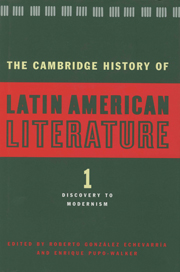Book contents
- Frontmatter
- Introduction to Volume 1
- 1 A brief history of the history of Spanish American Literature
- 2 Cultures in contact: Mesoamerica, the Andes, and the European written tradition
- 3 The first fifty years of Hispanic New World historiography: the Caribbean, Mexico, and Central America
- 4 Historians of the conquest and colonization of the New World: 1550–1620
- 5 Historians of the colonial period: 1620–1700
- 6 Colonial lyric
- 7 Epic poetry
- 8 Spanish American theatre of the colonial period
- 9 Viceregal culture
- 10 The eighteenth century: narrative forms, scholarship, and learning
- 11 Lyric poetry of the eighteenth and nineteenth centuries
- 12 Spanish American theatre of the eighteenth century
- 13 The nineteenth-century Spanish American novel
- 14 The brief narrative in Spanish America: 1835–1915
- 15 The Spanish American theatre of the nineteenth century
- 16 The essay in Spanish South America: 1800 to Modernismo
- 17 The essay of nineteenth-century Mexico, Central America, and the Caribbean
- 18 The gaucho genre
- Index
- Bibliographies
- References
11 - Lyric poetry of the eighteenth and nineteenth centuries
Published online by Cambridge University Press: 28 March 2008
- Frontmatter
- Introduction to Volume 1
- 1 A brief history of the history of Spanish American Literature
- 2 Cultures in contact: Mesoamerica, the Andes, and the European written tradition
- 3 The first fifty years of Hispanic New World historiography: the Caribbean, Mexico, and Central America
- 4 Historians of the conquest and colonization of the New World: 1550–1620
- 5 Historians of the colonial period: 1620–1700
- 6 Colonial lyric
- 7 Epic poetry
- 8 Spanish American theatre of the colonial period
- 9 Viceregal culture
- 10 The eighteenth century: narrative forms, scholarship, and learning
- 11 Lyric poetry of the eighteenth and nineteenth centuries
- 12 Spanish American theatre of the eighteenth century
- 13 The nineteenth-century Spanish American novel
- 14 The brief narrative in Spanish America: 1835–1915
- 15 The Spanish American theatre of the nineteenth century
- 16 The essay in Spanish South America: 1800 to Modernismo
- 17 The essay of nineteenth-century Mexico, Central America, and the Caribbean
- 18 The gaucho genre
- Index
- Bibliographies
- References
Summary
From the early fiction of Jorge Luis Borges, where Cervantes is writ large of course, but where Quevedo, too, appears in the fine print of the oeuvre of Pierre Menard, to José Lezama Lima’s life-long commitment to a Gongorine aesthetic in the lyric, to Octavio Paz’s more recent essay on Sor Juana (Sor juana Inés de la Cruz), the leading figures of Spanish American letters in the twentieth century have set their writing in a direct relation to the Baroque. They have done so with the clear precedent of their peninsular forerunners, who, particularly in the area of the lyric, identified avant-garde activities with the reading of Góngora. But just as the commemorative acts surrounding the tercentenary of Góngora’s death in 1927 may be read as a deflection or defense, a willful nationalistic redefinition of vanguard influences crossing into Spain from France and elsewhere, so too, the immediacy of the baroque heritage in twentieth-century Spanish America calls for a critical assessment. Following the lead of Borges, Lezama and Paz, amongst other practitioners of the Neo-Baroque, has brought important benefits to contemporary criticism, it is true, most notably the recuperation, if not to say reinvention of colonial letters in our time through the valorization of the Barroco de Indias, a period obscured by nearly 200 years of the ideology of independence. Nevertheless, the emphasis on baroque ancestry, whether in lyric style or literary scholarship, has, like T. S. Eliot’s attachment to the English metaphysical poets and the corresponding literary historical orientation of the American New Critics, had the deleterious effect of obscuring in turn that very period - the late eighteenth and the nineteenth centuries - in which both political and literary independence took their shape.
- Type
- Chapter
- Information
- The Cambridge History of Latin American Literature , pp. 375 - 400Publisher: Cambridge University PressPrint publication year: 1996
References
- 1
- Cited by



